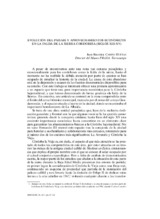Evolución del paisaje y aprovechamientos económicos en la falda de la sierra cordobesa (Siglos XIII-XV)
Autor
Carpio Dueñas, Juan Bautista
Editor
Facultad de Filosofía y Letras. Departamento de Ciencias de la Antigüedad y Edad MediaFecha
2011Materia
PaisajeAprovechamientos
Córdoba (España)
Agricultura
Ganadería
Landscape
Utilizations
Agriculture
Ranching
METS:
Mostrar el registro METSPREMIS:
Mostrar el registro PREMISMetadatos
Mostrar el registro completo del ítemResumen
La falda de la sierra cordobesa forma un espacio unitario íntimamente conectado geográfica, emocional y económicamente con la ciudad. En este espacio se sitúan elementos históricos tan importantes como el heredamiento de la Albaida o, sobre todo, la dehesa de Córdoba la Vieja, que recibe este nombre por encontrarse en su interior las ruinas de la antigua ciudad omeya de Madinat al-Zahra. Tradicionalmente se ha presentado este espacio como una amplia dehesa dedicada a la ganadería extensiva. Sin embargo, un estudio más detallado de las fuentes documentales disponibles nos muestra un paisaje diversificado en el que, junto con los pastos para el ganado, abundan olivares, viñas y huertas que fueron fundamentales para el abastecimiento de los mercados de la ciudad de Córdoba durante la Baja Edad Media. The foot of the Cordoba mountain range forms a geographical area intimately, emotionally and fi nancially connected to the city. In this place, important historic elements are located, such as the inheritance from Albaida and, above all, the meadow of Córdoba la Vieja, which is named after the ruins of the old Umayyad city of Madinat al- Zahra, which are situated inside aforementioned the meadow. Traditionally, this has been considered a large meadow area dedicated to extensive cattle farming. However, a more detailed study of available documentary sources shows a diversifi ed landscape. Here, along with pastures for cattle, there is an abundance of olive groves, vineyards and orchards that were central to the supply of market in the city of Cordoba during the Late Middle Ages.

